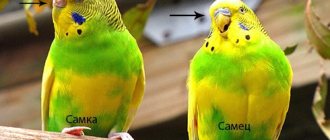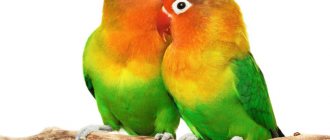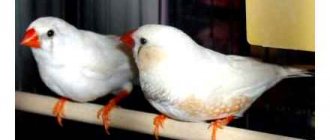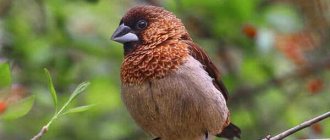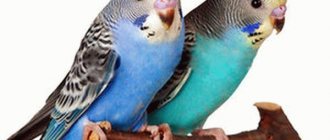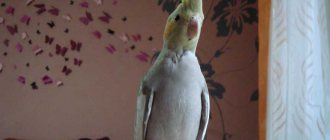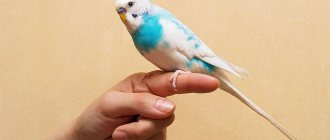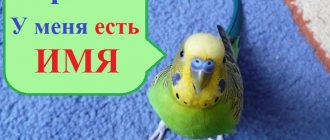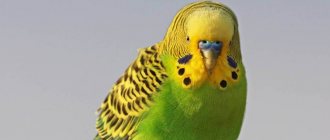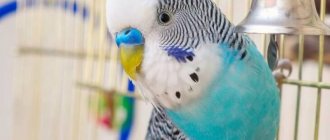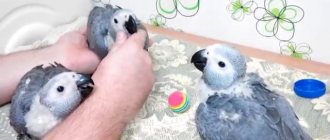Dear friends, in this article we will look at the main varieties of budgies. Why only the main ones? Because in our time there are many species of these birds, there is a huge variety of colors and shapes of plumage. At the moment, there are thirty-two primary and over one hundred secondary mutations. For this reason, in this article we will talk only about the most common varieties and breeds of budgerigars.
Genetics
In the wild (namely, in its homeland, in the tropical greenery of Australia), the budgie predominantly has green plumage (more precisely, light green), so that it can easily get lost in the grass and leaves of trees.
Interestingly, the appearance of green in this case is due to an optical illusion that distorts the yellow and black pigments that are present in bird plumage.
See the photo below for what a green budgerigar looks like.
The appearance of green coloring in parrots in their natural environment does not cause difficulties, since they are surrounded by relatives who have the same color. However, even in such circumstances, it may happen that the result of mating between a male and a female will be the birth of a parrot with a different plumage color from the parents. This phenomenon occurs when the parents of a chick pass on different hereditary characteristics to it. This is not good, since such a parrot becomes a noticeable target for predatory animals. Also, a flock may refuse to accept a stranger. Therefore, unfortunately, such unique birds do not live long in the wild.
Another thing is domestic budgies. They live comfortably, calmly, without fear of predators (unless, of course, there is some kind of “predatory animal” in the house, for example, a hunter cat) and have a wide variety of colors. Such a variety of different budgies became possible thanks to selection.
There are two basic colors of artificially bred domestic budgerigars: white; yellow. Those who have a white base also have, for example, gray or blue. Those whose main color is yellow may have, for example, grayish-green or green plumage.
Maintenance, care, feeding at home
The food is based on grain mixtures, which you can make yourself or buy ready-made. These are flax, sesame, sunflower, oats, canary seed and the like. In winter they feed sprouted wheat.
Budgerigar - Interesting facts about the bird species
In our climate, it is necessary to maintain the required air temperature and humidity (+22-25, 55-70%, respectively). To prevent overheating, you need a bath and a humidifier. Be sure to regulate daylight hours. It should be as close in duration as possible to the Australian one (12 hours in winter, 14 in summer). The cage and accessories are spilled with boiling water before the bird is introduced. The tray is cleaned daily. General cleaning is carried out once a week. The parrot must fly, so it is let out of its cage every day for at least an hour. You can also buy a home that is so spacious that there will be no lack of movement.
Varieties of colors
There are different types of colors of budgies. Let's look at them with you.
Standard color
Parrots that have this type of coloring look like this:
- their mask is lighter than their plumage;
- there are uniform stripes on the back;
- there are 6 throat spots.
Opaline coloring
Budgerigars that have this color have the following external features:
- They do not have uniform, clear stripes on the back and back of the head.
- The mask has a color that spreads across the front and top of the head. It is then covered by vaguely colored waves. The result of gradation is a mixture of the main and given colors.
- Often parrots that have this coloration have either dark gray or black markings on their wings. Sometimes these markings obscure the yellow or white pigment that dominates the bird's plumage.
Nutrition
The basis of the wavy's diet is grain. Special grain mixtures can be purchased in stores or prepared independently.
It is best to use the following cereals:
- Millet.
- Corn.
- Oats.
- Sesame.
It would be a good idea to add the following treats to your pet’s diet:
- Vegetables. Suitable carrots, cabbage, cucumbers, tomatoes.
- Citrus fruits, pears and apples, bananas, and kiwi are ideal fruits.
- From berries you can choose strawberries, raspberries, rowan or blackberries.
- Various greens that can be purchased at any grocery store.
Budgerigars that have mixed genes
The vast majority of colors of budgerigars can mix with each other. Chicks whose father and mother have the same genotype express the dominant characteristics of their parents twice as clearly.
Interestingly, spangles, as a result of crossing with each other, produce offspring that have an “albino” color. These budgies have entirely, one hundred percent white feathers. They are distinguished from albinos by their dark eye color.
See below a photo of a white budgerigar boy and a photo of an albino. At the same time, pay attention to the color of the parrots' eyes.
Habitat, habitat in the wild
A variety of birds of this species have settled throughout almost all of Australia, except for deserts. They live in Tasmania, on many large and small islands located nearby.
BREEDING BUDGETS || PROS AND CONS OF BREEDING
Usually the flock wanders from place to place in search of food, preferring open forests, steppe zones and semi-deserts. These are the places that are located on the east and west coasts, in the center of the mainland. Only in the north in dense forests is life impossible for them.
Rare colors and mutations of budgies
Crested
Crested budgies have a crest on their head. It can be in the form of a bunch, a circle or a semicircle. There are individuals that have random feather tufts on the back and wings.
Rainbow
Parrots with this mutation have an unusual combination of waves and shades that include very bright colors.
Saddlebacks
Budgerigars, which are classified in this category, have a large number of darkish-gray markings in the saddle area. At the same time, there are few of them on the bird’s head.
Thus, we have examined with you the main varieties of these exotic birds. Of course, there are many other species among budgerigars. Therefore, next I will show you what other types of these pets there are. To do this, I present to you beautiful images of budgerigars of a wide variety of shades and colors. The rarest species of these amazing birds will also be shown here. Enjoy viewing the photos I have presented below.
Gray
Adding a gray factor allows you to get several shades of gray. Depending on what color the bird is taken as the basis for breeding (green or blue), we get gray or gray-green individuals.
Important! Regardless of the color of your pets, you can cross them with each other, thus joining in the exciting breeding work. Nevertheless, in order for it to be successful, it is still better to study the basics of the genetics of “wavy animals”. If you don’t want to experiment, you can follow one basic rule: when crossing individuals of the same genotype, the offspring will have the same color, but the colors of the chicks will be much brighter than those of the parents.
Gray (also called dominant or Australian grey) budgies can come in a variety of shades, but one of the rarest and most beautiful colors in this series is anthracite. The plumage of this bird is so dark that it appears black, sometimes with white splashes.
This coloring owes its appearance to German breeders, although in fairness it must be said that back in the 30s of the last century, gray parrots of a very dark shade were bred in England, however, unfortunately, this variety was not preserved (mainly due to the fact that that the dark gray color acted as a recessive factor in the genotype and was thus lost when crossed with any other individual).
Additional photos
The photographs show, in descending order, the following varieties of budgies: another crested, harlequin (the color is differentiated on the chest and tummy), lutinous (it has yellow feathers without a pattern), fallow (distinguished by the red color of the eyes), brown-winged (theirs are not so bright plumage color, like cinnamon), mottled, anthracite, slate, sky blue misty (from English “fuzzy”, “unclear”), celandine, curly, lace wing (have “lace wings”), black-faced, gray, black, yellow-faced blue spangle, turquoise and light blue budgie girl.
How to choose and where to buy a bird for life in captivity
First of all, it is worth checking the age of the pet. The chicks do not leave the nest for about a month from the moment of birth. After 30-40 days, the young learn to feed on their own.
At one and a half months of age, parrots become strong enough to adapt to a new place of residence.
Mature individuals can be distinguished by means of the cere. In males it is bright blue, and in females it is brown. The age of the pet is determined by the pattern on the back of the head: the older the bird, the clearer the stripes. In young animals this zone is blurred or completely absent.
Before choosing, be sure to conduct a visual inspection of the parrot. A healthy bird has the following characteristics:
- is active;
- confident grip of the pole;
- the plumage gives off a gloss;
- clean beak without whitish “web”;
- there are no growths or roughness on the wax;
- clean nostrils;
- hard shiny claws;
- the abdomen does not sag.
Signs of a sick bird:
- apathetic state;
- rushes around the cage randomly;
- gets stuck in the corner;
- delamination on the beak;
- matted and faded feathers;
- growths on the paws;
- wrinkled cere.
It is more advisable to buy a pet from professional breeders. The latter, as a rule, have their own websites or are advertised through the local paper press. You can find them on ad aggregators, like Avito.
It is also worth going to large pet stores, better branded or chain stores, where the likelihood of deceiving the buyer is reduced to zero. There are more than enough of these in large cities. Buying a budgerigar at a bird market is fraught with serious consequences.
And the point is not only that unscrupulous sellers can slip a sick or elderly bird. An animal can be a carrier of parasitic insects and infectious diseases. Whereas professional breeders and pet stores provide documentation where, in addition to the breed, the vaccinations given and the results of a veterinarian’s examination are noted.
The cost of a budgie depends on its age and acquired skills. For example, a sexually mature talking bird costs about 3-5 thousand rubles, while a 1.5-month-old young bird will cost 500-1000 rubles from a professional breeder.
